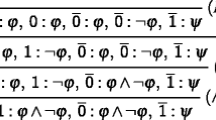Abstract
We explore in an experimental spirit the prospects for extending classical propositional logic with a new operator P intended to be interpreted when prefixed to a formula as saying that formula in question is at least partly true. The paradigm case of something which is, in the sense envisaged, false though still “partly” true is a conjunction one of whose conjuncts is false while the other is true. Ideally, we should like such a logic to extend classical logic – or any fragment thereof under consideration – conservatively, to be closed under uniform substitution (of arbitrary formulas for sentence letters or propositional variables), and to allow the substitutivity of provably equivalent formulas salva provabilitate. To varying degrees, we experience some difficulties only with this last (‘congruentiality’) desideratum in the two four-valued logics we end up giving our most extended consideration to.
Similar content being viewed by others
REFERENCES
Anderson, A. R. and Belnap, N. D.: Entailment: The Logic of Relevance and Necessity, Vol. I, Princeton University Press, Princeton, NJ, 1975.
Blamey, S.: Partial logic, in D. M. Gabbay and F. Guenthner (eds.), Handbook of Philosophical Logic III: Alternatives to Classical Logic, Reidel, Dordrecht, 1986, pp. 1–70.
Bradley, F. H.: The Principles of Logic, Vol. I, 2nd edn, Oxford University Press, 1992 (First edition 1883).
Brink, C.: Power structures, Algebra Universalis 39 (1992), 177–216.
Brzozowski, J. A.: De Morgan bisemilattices, in 30th IEEE International Symposium on Multiple-Valued Logic, IEEE Computer Society, Los Alamitos, CA, 2000, pp. 173–178.
Cooper, W. S.: The propositional logic of ordinary discourse, Inquiry 11 (1968), 295–320.
Cresswell, M. J.: Classical intensional logics, Theoria 36 (1970), 347–372.
Demos, R.: Partly so and partly not so, Mind 68 (1959), 51–56.
Fuhrmann, A.: When hyperpropositions meet..., J. Philos. Logic 28 (1999), 559–574.
Gautam, N. D.: The validity of equations of complex algebras, Math. Logik und Grundlagenforsch. 3 (1957), 117–124.
Goldblatt, R.: Varieties of complex algebras, Ann. Pure Appl. Logic 44 (1989), 173–242.
Humberstone, L.: Logical subtraction: Problems and prospects, Talk given at a University College (London) philosophy colloquium, 1981.
Humberstone, L.: Singulary extensional connectives: A aloser look, J. Philos. Logic 26 (1997), 341–356.
Humberstone, L.: Contra-classical logics, Australasian Journal of Philosophy 78 (2000), 437–474.
Humberstone, L.: Parts and partitions, Theoria 66 (2000), 41–82.
Lewis, D.: General semantics, in D. Davidson and G. Harman (eds.), Semantics of Natural Language, Reidel, Dordrecht, 1972, pp. 169–218.
Lewis, D.: Statements partly about observation, Philosophical Papers 17 (1988), 1–31.
Miller, D.: Popper's qualitative theory of verisimilitude, British J. Philos. Sci. 25 (1974), 166–177.
Miller, D.: Verisimilitude redeflated, British J. Philos. Sci. 27 (1976), 363–402.
Oddie, G.: Likeness to Truth, Reidel, Dordrecht, 1986.
Rautenberg, W.: A calculus for the common rules of ∧ and ∨, Studia Logica 48 (1989), 531–537.
Rautenberg, W.: Axiomatization of semigroup consequences, Arch. Math. Logic 29 (1989), 111–123.
Rautenberg, W.: Common logic of 2-valued semigroup connectives, Z. Math. Logik Grundlag. Math. 37 (1991), 187–192.
Rescher, N.: Many-Valued Logic, McGraw-Hill, New York, 1969.
Romanowska, A.: On distributivity of bisemilattices with one distributive law, in B. Csákány et al. (eds.), Colloquia Mathematica Societatis János Bolyai 29: Universal Algebra, Esztergom (Hungary), 1977, pp. 653–661.
Sainsbury, R. M.: Degrees of truth and degrees of truth, Philosophical Papers 15 (1986), 97–106.
Scott, D. S.: Completeness and axiomatizability in many-valued logic, in L. Henkin et al. (eds.), Procs. of the Tarski Symposium, Amer. Math. Soc., Providence, RI, 1974, pp. 188–197.
Segerberg, K.: Classical Propositional Operators, Clarendon Press, Oxford, 1982.
Shafaat, A.: On varieties closed under the construction of power algebras, Bull. Australian Math. Soc. 11 (1974), 213–218.
Shoesmith, D. J. and Smiley, T. J.: Multiple-Conclusion Logic, Cambridge University Press, Cambridge, 1978.
Stalnaker, R. C.: Complex predicates, The Monist 60 (1977), 327–339.
Tichý, P.: On Popper's definitions of verisimilitude, British J. Philos. Sci. 27 (1974), 155–160.
van Fraassen, B.: Facts and tautological entailments, J. Philos. 66 (1969), 477–487.
Wollheim, R.: F. H. Bradley, Penguin Books, Harmondsworth, Middlesex, 1959.
Rights and permissions
About this article
Cite this article
Humberstone, L. False Though Partly True – An Experiment in Logic. Journal of Philosophical Logic 32, 613–665 (2003). https://doi.org/10.1023/B:LOGI.0000003922.76154.69
Issue Date:
DOI: https://doi.org/10.1023/B:LOGI.0000003922.76154.69




